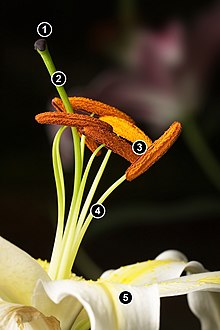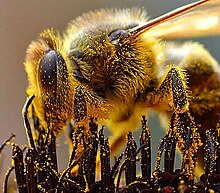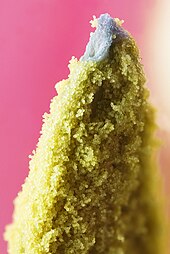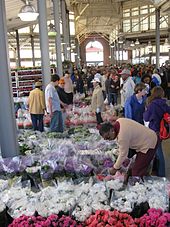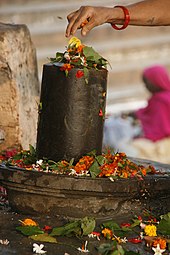
| Home | Sources Directory | News Releases | Calendar | Articles | | Contact | |
Flower
A flower, sometimes known as a bloom or blossom, is the reproductive structure found in flowering plants (plants of the division Magnoliophyta, also called angiosperms). The biological function of a flower is to mediate the union of male sperm with female ovum in order to produce seeds. The process begins with pollination, is followed by fertilization, leading to the formation and dispersal of the seeds. For the higher plants, seeds are the next generation, and serve as the primary means by which individuals of a species are dispersed across the landscape. The grouping of flowers on a plant is called the inflorescence.
In addition to serving as the reproductive organs of flowering plants, flowers have long been admired and used by humans, mainly to beautify their environment but also as a source of food.
Contents |
Flower specialization and pollination
Flowering plants usually face selective pressure to optimise the transfer of their pollen, and this is typically reflected in the morphology of the flowers and the behaviour of the plants. Pollen may be transferred between plants via a number of 'vectors'. Some plants make use of abiotic vectors ' namely wind (anemophily) or, much less commonly, water (hydrophily). Others use biotic vectors including insects (entomophily), birds (ornithophily), bats (chiropterophily) or other animals. Some plants make use of multiple vectors, but many are highly specialised.
Cleistogamous flowers are self pollinated, after which they may or may not open. Many Viola and some Salvia species are known to have these types of flowers.
The flowers of plants that make use of biotic pollen vectors commonly have glands called nectaries that act as an incentive for animals to visit the flower. Some flowers have patterns, called nectar guides, that show pollinators where to look for nectar. Flowers also attract pollinators by scent and color. Still other flowers use mimicry to attract pollinators. Some species of orchids, for example, produce flowers resembling female bees in color, shape, and scent. Flowers are also specialized in shape and have an arrangement of the stamens that ensures that pollen grains are transferred to the bodies of the pollinator when it lands in search of its attractant (such as nectar, pollen, or a mate). In pursuing this attractant from many flowers of the same species, the pollinator transfers pollen to the stigmas'arranged with equally pointed precision'of all of the flowers it visits.
Anemophilous flowers use the wind to move pollen from one flower to the next. Examples include grasses, birch trees, ragweed and maples. They have no need to attract pollinators and therefore tend not to be "showy" flowers. Male and female reproductive organs are generally found in separate flowers, the male flowers having a number of long filaments terminating in exposed stamens, and the female flowers having long, feather-like stigmas. Whereas the pollen of animal-pollinated flowers tends to be large-grained, sticky, and rich in protein (another "reward" for pollinators), anemophilous flower pollen is usually small-grained, very light, and of little nutritional value to animals.
Morphology
Flowering plants are heterosporangiate, producing two types of reproductive spores. The pollen (male spores) and ovules (female spores) are produced in different organs, but the typical flower is a bisporangiate strobilus in that it contains both organs.
A flower is regarded as a modified stem with shortened internodes and bearing, at its nodes, structures that may be highly modified leaves.[1] In essence, a flower structure forms on a modified shoot or axis with an apical meristem that does not grow continuously (growth is determinate). Flowers may be attached to the plant in a few ways. If the flower has no stem but forms in the axil of a leaf, it is called sessile. When one flower is produced, the stem holding the flower is called a peduncle. If the peduncle ends with groups of flowers, each stem that holds a flower is called a pedicel. The flowering stem forms a terminal end which is called the torus or receptacle. The parts of a flower are arranged in whorls on the torus. The four main parts or whorls (starting from the base of the flower or lowest node and working upwards) are as follows:
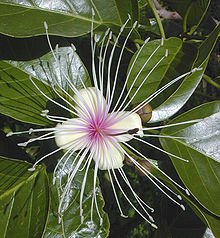
- Calyx: the outer whorl of sepals; typically these are green, but are petal-like in some species.
- Corolla: the whorl of petals, which are usually thin, soft and colored to attract animals that help the process of pollination. The coloration may extend into the ultraviolet, which is visible to the compound eyes of insects, but not to the eyes of birds.
- Androecium (from Greek andros oikia: man's house): one or two whorls of stamens, each a filament topped by an anther where pollen is produced. Pollen contains the male gametes.
- Gynoecium (from Greek gynaikos oikia: woman's house): one or more pistils. The female reproductive organ is the carpel: this contains an ovary with ovules (which contain female gametes). A pistil may consist of a number of carpels merged together, in which case there is only one pistil to each flower, or of a single individual carpel (the flower is then called apocarpous). The sticky tip of the pistil, the stigma, is the receptor of pollen. The supportive stalk, the style becomes the pathway for pollen tubes to grow from pollen grains adhering to the stigma, to the ovules, carrying the reproductive material.
Although the floral structure described above is considered the "typical" structural plan, plant species show a wide variety of modifications from this plan. These modifications have significance in the evolution of flowering plants and are used extensively by botanists to establish relationships among plant species. For example, the two subclasses of flowering plants may be distinguished by the number of floral organs in each whorl: dicotyledons typically having 4 or 5 organs (or a multiple of 4 or 5) in each whorl and monocotyledons having three or some multiple of three. The number of carpels in a compound pistil may be only two, or otherwise not related to the above generalization for monocots and dicots.
In the majority of species individual flowers have both pistils and stamens as described above. These flowers are described by botanists as being perfect, bisexual, or hermaphrodite. However, in some species of plants the flowers are imperfect or unisexual: having only either male (stamens) or female (pistil) parts. In the latter case, if an individual plant is either female or male the species is regarded as dioecious. However, where unisexual male and female flowers appear on the same plant, the species is considered monoecious.
Additional discussions on floral modifications from the basic plan are presented in the articles on each of the basic parts of the flower. In those species that have more than one flower on an axis'so-called composite flowers'the collection of flowers is termed an inflorescence; this term can also refer to the specific arrangements of flowers on a stem. In this regard, care must be exercised in considering what a ''flower'' is. In botanical terminology, a single daisy or sunflower for example, is not a flower but a flower head'an inflorescence composed of numerous tiny flowers (sometimes called florets). Each of these flowers may be anatomically as described above. Many flowers have a symmetry, if the perianth is bisected through the central axis from any point, symmetrical halves are produced'the flower is called regular or actinomorphic, e.g. rose or trillium. When flowers are bisected and produce only one line that produces symmetrical halves the flower is said to be irregular or zygomorphic. e.g. snapdragon or most orchids.
Floral formula
A floral formula is a way to represent the structure of a flower using specific letters, numbers, and symbols. Typically, a general formula will be used to represent the flower structure of a plant family rather than a particular species. The following representations are used:
Ca = calyx (sepal whorl; e. g. Ca5 = 5 sepals)
Co = corolla (petal whorl; e. g., Co3(x) = petals some multiple of three )
Z = add if zygomorphic (e. g., CoZ6 = zygomorphic with 6 petals)
A = androecium (whorl of stamens; e. g., A–ž = many stamens)
G = gynoecium (carpel or carpels; e. g., G1 = monocarpous)
x: to represent a "variable number"
–ž: to represent "many"
A floral formula would appear something like this:
- Ca5Co5A10 - –žG1
Several additional symbols are sometimes used (see Key to Floral Formulas).
The four main parts of a flower are generally defined by their positions on the receptacle and not by their function. Many flowers lack some parts or parts may be modified into other functions and/or look like what is typically another part. In some families, like Ranunculaceae, the petals are greatly reduced and in many species the sepals are colorful and petal-like. Other flowers have modified stamens that are petal-like, the double flowers of Peonies and Roses are mostly petaloid stamens.[2] Flowers show great variation and plant scientists describe this variation in a systematic way to identify and distinguish species.
Specific terminology is used to descried flowers and their parts. Many flower parts are fused together; fused parts originating from the same whorl are connate, while fused parts originating from different whorls are adnate, parts that are not fused are free. When petals are fused into a tube or ring that falls away as a single unit, they are sympetalous (also called gamopetalous.) Petals that are connate may have distinctive regions: the cylindrical base is the tube, the expanding region is the throat and the flaring outer region is the limb. A sympetalous flower, with bilateral symmetry with an upper and lower lip, is bilabiate. Flowers with connate petals or sepals may have various shaped corolla or calyx including: campanulate, funnelform, tubular, urceolate, salverform or rotate.
Development
Flowering transition
The transition to flowering is one of the major phase changes that a plant makes during its life cycle. The transition must take place at a time that is favorable for fertilization and the formation of seeds, hence ensuring maximal reproductive success. To meet these needs a plant is able to interpret important endogenous and environmental cues such as changes in levels of plant hormones and seasonable temperature and photoperiod changes.[3] Many perennial and most biennial plants require vernalization to flower. The molecular interpretation of these signals is through the transmission of a complex signal known as florigen, which involves a variety of genes, including CONSTANS, FLOWERING LOCUS C and FLOWERING LOCUS T. Florigen is produced in the leaves in reproductively favorable conditions and acts in buds and growing tips to induce a number of different physiological and morphological changes.[4] The first step is the transformation of the vegetative stem primordia into floral primordia. This occurs as biochemical changes take place to change cellular differentiation of leaf, bud and stem tissues into tissue that will grow into the reproductive organs. Growth of the central part of the stem tip stops or flattens out and the sides develop protuberances in a whorled or spiral fashion around the outside of the stem end. These protuberances develop into the sepals, petals, stamens, and carpels. Once this process begins, in most plants, it cannot be reversed and the stems develop flowers, even if the initial start of the flower formation event was dependent of some environmental cue.[5] Once the process begins, even if that cue is removed the stem will continue to develop a flower.
Organ development
The molecular control of floral organ identity determination is fairly well understood. In a simple model, three gene activities interact in a combinatorial manner to determine the developmental identities of the organ primordia within the floral meristem. These gene functions are called A, B and C-gene functions. In the first floral whorl only A-genes are expressed, leading to the formation of sepals. In the second whorl both A- and B-genes are expressed, leading to the formation of petals. In the third whorl, B and C genes interact to form stamens and in the center of the flower C-genes alone give rise to carpels. The model is based upon studies of homeotic mutants in Arabidopsis thaliana and snapdragon, Antirrhinum majus. For example, when there is a loss of B-gene function, mutant flowers are produced with sepals in the first whorl as usual, but also in the second whorl instead of the normal petal formation. In the third whorl the lack of B function but presence of C-function mimics the fourth whorl, leading to the formation of carpels also in the third whorl. See also The ABC Model of Flower Development.
Most genes central in this model belong to the MADS-box genes and are transcription factors that regulate the expression of the genes specific for each floral organ.
Pollination
The primary purpose of a flower is reproduction. Since the flowers are the reproductive organs of plant, they mediate the joining of the sperm, contained within pollen, to the ovules ' contained in the ovary. Pollination is the movement of pollen from the anthers to the stigma. The joining of the sperm to the ovules is called fertilization. Normally pollen is moved from one plant to another, but many plants are able to self pollinate. The fertilized ovules produce seeds that are the next generation. Sexual reproduction produces genetically unique offspring, allowing for adaptation. Flowers have specific designs which encourages the transfer of pollen from one plant to another of the same species. Many plants are dependent upon external factors for pollination, including: wind and animals, and especially insects. Even large animals such as birds, bats, and pygmy possums can be employed. The period of time during which this process can take place (the flower is fully expanded and functional) is called anthesis.
Attraction methods
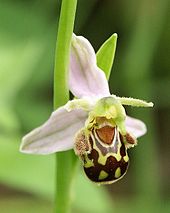
Plants can not move from one location to another, thus many flowers have evolved to attract animals to transfer pollen between individuals in dispersed populations. Flowers that are insect-pollinated are called entomophilous; literally "insect-loving" in Latin. They can be highly modified along with the pollinating insects by co-evolution. Flowers commonly have glands called nectaries on various parts that attract animals looking for nutritious nectar. Birds and bees have color vision, enabling them to seek out "colorful" flowers. Some flowers have patterns, called nectar guides, that show pollinators where to look for nectar; they may be visible only under ultraviolet light, which is visible to bees and some other insects. Flowers also attract pollinators by scent and some of those scents are pleasant to our sense of smell. Not all flower scents are appealing to humans, a number of flowers are pollinated by insects that are attracted to rotten flesh and have flowers that smell like dead animals, often called Carrion flowers including Rafflesia, the titan arum, and the North American pawpaw (Asimina triloba). Flowers pollinated by night visitors, including bats and moths, are likely to concentrate on scent to attract pollinators and most such flowers are white.
Still other flowers use mimicry to attract pollinators. Some species of orchids, for example, produce flowers resembling female bees in color, shape, and scent. Male bees move from one such flower to another in search of a mate.
Pollination mechanism
The pollination mechanism employed by a plant depends on what method of pollination is utilized.
Most flowers can be divided between two broad groups of pollination methods:
Entomophilous: flowers attract and use insects, bats, birds or other animals to transfer pollen from one flower to the next. Often they are specialized in shape and have an arrangement of the stamens that ensures that pollen grains are transferred to the bodies of the pollinator when it lands in search of its attractant (such as nectar, pollen, or a mate). In pursuing this attractant from many flowers of the same species, the pollinator transfers pollen to the stigmas'arranged with equally pointed precision'of all of the flowers it visits. Many flowers rely on simple proximity between flower parts to ensure pollination. Others, such as the Sarracenia or lady-slipper orchids, have elaborate designs to ensure pollination while preventing self-pollination.

Anemophilous: flowers use the wind to move pollen from one flower to the next, examples include the grasses, Birch trees, Ragweed and Maples. They have no need to attract pollinators and therefore tend not to be "showy" flowers. Whereas the pollen of entomophilous flowers tends to be large-grained, sticky, and rich in protein (another "reward" for pollinators), anemophilous flower pollen is usually small-grained, very light, and of little nutritional value to insects, though it may still be gathered in times of dearth. Honeybees and bumblebees actively gather anemophilous corn (maize) pollen, though it is of little value to them.
Some flowers are self pollinated and use flowers that never open or are self pollinated before the flowers open, these flowers are called cleistogamous. Many Viola species and some Salvia have these types of flowers.
Flower-pollinator relationships
Many flowers have close relationships with one or a few specific pollinating organisms. Many flowers, for example, attract only one specific species of insect, and therefore rely on that insect for successful reproduction. This close relationship is often given as an example of coevolution, as the flower and pollinator are thought to have developed together over a long period of time to match each other's needs.
This close relationship compounds the negative effects of extinction. The extinction of either member in such a relationship would mean almost certain extinction of the other member as well. Some endangered plant species are so because of shrinking pollinator populations.
Fertilization and dispersal

Some flowers with both stamens and a pistil are capable of self-fertilization, which does increase the chance of producing seeds but limits genetic variation. The extreme case of self-fertilization occurs in flowers that always self-fertilize, such as many dandelions. Conversely, many species of plants have ways of preventing self-fertilization. Unisexual male and female flowers on the same plant may not appear or mature at the same time, or pollen from the same plant may be incapable of fertilizing its ovules. The latter flower types, which have chemical barriers to their own pollen, are referred to as self-sterile or self-incompatible (see also: Plant sexuality).
Evolution

While land plants have existed for about 425 million years, the first ones reproduced by a simple adaptation of their aquatic counterparts: spores. In the sea, plants'and some animals'can simply scatter out genetic clones of themselves to float away and grow elsewhere. This is how early plants reproduced. But plants soon evolved methods of protecting these copies to deal with drying out and other abuse which is even more likely on land than in the sea. The protection became the seed, though it had not yet evolved the flower. Early seed-bearing plants include the ginkgo and conifers. The earliest fossil of a flowering plant, Archaefructus liaoningensis, is dated about 125 million years old.[6] Several groups of extinct gymnosperms, particularly seed ferns, have been proposed as the ancestors of flowering plants but there is no continuous fossil evidence showing exactly how flowers evolved. The apparently sudden appearance of relatively modern flowers in the fossil record posed such a problem for the theory of evolution that it was called an "abominable mystery" by Charles Darwin. Recently discovered angiosperm fossils such as Archaefructus, along with further discoveries of fossil gymnosperms, suggest how angiosperm characteristics may have been acquired in a series of steps.
Recent DNA analysis (molecular systematics)[7][8] shows that Amborella trichopoda, found on the Pacific island of New Caledonia, is the sister group to the rest of the flowering plants, and morphological studies[9] suggest that it has features which may have been characteristic of the earliest flowering plants.
The general assumption is that the function of flowers, from the start, was to involve other animals in the reproduction process. Pollen can be scattered without bright colors and obvious shapes, which would therefore be a liability, using the plant's resources, unless they provide some other benefit. One proposed reason for the sudden, fully developed appearance of flowers is that they evolved in an isolated setting like an island, or chain of islands, where the plants bearing them were able to develop a highly specialized relationship with some specific animal (a wasp, for example), the way many island species develop today. This symbiotic relationship, with a hypothetical wasp bearing pollen from one plant to another much the way fig wasps do today, could have eventually resulted in both the plant(s) and their partners developing a high degree of specialization. Island genetics is believed to be a common source of speciation, especially when it comes to radical adaptations which seem to have required inferior transitional forms. Note that the wasp example is not incidental; bees, apparently evolved specifically for symbiotic plant relationships, are descended from wasps.
Likewise, most fruit used in plant reproduction comes from the enlargement of parts of the flower. This fruit is frequently a tool which depends upon animals wishing to eat it, and thus scattering the seeds it contains.
While many such symbiotic relationships remain too fragile to survive competition with mainland animals and spread, flowers proved to be an unusually effective means of production, spreading (whatever their actual origin) to become the dominant form of land plant life.
While there is only hard proof of such flowers existing about 130 million years ago, there is some circumstantial evidence that they did exist up to 250 million years ago. A chemical used by plants to defend their flowers, oleanane, has been detected in fossil plants that old, including gigantopterids,[10] which evolved at that time and bear many of the traits of modern, flowering plants, though they are not known to be flowering plants themselves, because only their stems and prickles have been found preserved in detail; one of the earliest examples of petrification.
The similarity in leaf and stem structure can be very important, because flowers are genetically just an adaptation of normal leaf and stem components on plants, a combination of genes normally responsible for forming new shoots.[11] The most primitive flowers are thought to have had a variable number of flower parts, often separate from (but in contact with) each other. The flowers would have tended to grow in a spiral pattern, to be bisexual (in plants, this means both male and female parts on the same flower), and to be dominated by the ovary (female part). As flowers grew more advanced, some variations developed parts fused together, with a much more specific number and design, and with either specific sexes per flower or plant, or at least "ovary inferior".
Flower evolution continues to the present day; modern flowers have been so profoundly influenced by humans that many of them cannot be pollinated in nature. Many modern, domesticated flowers used to be simple weeds, which only sprouted when the ground was disturbed. Some of them tended to grow with human crops, and the prettiest did not get plucked because of their beauty, developing a dependence upon and special adaptation to human affection.[12]
Symbolism

Lilies are often used to denote life or resurrection
|
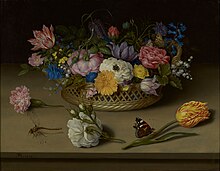
Flowers are common subjects of still life paintings, such as this one by Ambrosius Bosschaert the Elder
|
Many flowers have important symbolic meanings in Western culture. The practice of assigning meanings to flowers is known as floriography. Some of the more common examples include:
- Red roses are given as a symbol of love, beauty, and passion.
- Poppies are a symbol of consolation in time of death. In the UK, New Zealand, Australia and Canada, red poppies are worn to commemorate soldiers who have died in times of war.
- Irises/Lily are used in burials as a symbol referring to "resurrection/life". It is also associated with stars (sun) and its petals blooming/shining.
- Daisies are a symbol of innocence.
Flowers within art are also representative of the female genitalia, as seen in the works of artists such as Georgia O'Keeffe, Imogen Cunningham, Veronica Ruiz de Velasco, and Judy Chicago, and in fact in Asian and western classical art. Many cultures around the world have a marked tendency to associate flowers with femininity.
The great variety of delicate and beautiful flowers has inspired the works of numerous poets, especially from the 18th-19th century Romantic era. Famous examples include William Wordsworth's I Wandered Lonely as a Cloud and William Blake's Ah! Sun-Flower.
Because of their varied and colorful appearance, flowers have long been a favorite subject of visual artists as well. Some of the most celebrated paintings from well-known painters are of flowers, such as Van Gogh's sunflowers series or Monet's water lilies. Flowers are also dried, freeze dried and pressed in order to create permanent, three-dimensional pieces of flower art.
The Roman goddess of flowers, gardens, and the season of Spring is Flora. The Greek goddess of spring, flowers and nature is Chloris.
In Hindu mythology, flowers have a significant status. Vishnu, one of the three major gods in the Hindu system, is often depicted standing straight on a lotus flower.[13] Apart from the association with Vishnu, the Hindu tradition also considers the lotus to have spiritual significance.[14] For example, it figures in the Hindu stories of creation.[15]
Usage
In modern times, people have sought ways to cultivate, buy, wear, or otherwise be around flowers and blooming plants, partly because of their agreeable appearance and smell. Around the world, people use flowers for a wide range of events and functions that, cumulatively, encompass one's lifetime:
- For new births or Christenings
- As a corsage or boutonniere to be worn at social functions or for holidays
- As tokens of love or esteem
- For wedding flowers for the bridal party, and decorations for the hall
- As brightening decorations within the home
- As a gift of remembrance for bon voyage parties, welcome home parties, and "thinking of you" gifts
- For funeral flowers and expressions of sympathy for the grieving
- For worshiping goddesses. in Hindu culture it is very common to bring flowers as a gift to temples.
People therefore grow flowers around their homes, dedicate entire parts of their living space to flower gardens, pick wildflowers, or buy flowers from florists who depend on an entire network of commercial growers and shippers to support their trade.
Flowers provide less food than other major plants parts (seeds, fruits, roots, stems and leaves) but they provide several important foods and spices. Flower vegetables include broccoli, cauliflower and artichoke. The most expensive spice, saffron, consists of dried stigmas of a crocus. Other flower spices are cloves and capers. Hops flowers are used to flavor beer. Marigold flowers are fed to chickens to give their egg yolks a golden yellow color, which consumers find more desirable. Dandelion flowers are often made into wine. Bee Pollen, pollen collected from bees, is considered a health food by some people. Honey consists of bee-processed flower nectar and is often named for the type of flower, e.g. orange blossom honey, clover honey and tupelo honey.
Hundreds of fresh flowers are edible but few are widely marketed as food. They are often used to add color and flavor to salads. Squash flowers are dipped in breadcrumbs and fried. Edible flowers include nasturtium, chrysanthemum, carnation, cattail, honeysuckle, chicory, cornflower, Canna, and sunflower. Some edible flowers are sometimes candied such as daisy and rose (you may also come across a candied pansy).
Flowers can also be made into herbal teas. Dried flowers such as chrysanthemum, rose, jasmine, camomile are infused into tea both for their fragrance and medical properties. Sometimes, they are also mixed with tea leaves for the added fragrance.
See also
- Gardening
- Garden
- List of garden plants
- Plant evolutionary developmental biology
- Plant sexuality
- Sowing
References
- ^ Eames, A. J. (1961) Morphology of the Angiosperms McGraw-Hill Book Co., New York.
- ^ Reynolds, Joan; Tampion, John (1983). Double flowers: a scientific study. London: [Published for the] Polytechnic of Central London Press [by] Pembridge Press. p. 41. ISBN 978-0-86206-004-6.
- ^ Ausín, I., et al. (2005). "Environmental regulation of flowering". Int J Dev Biol 49 (5-6): 689'705. doi:10.1387/ijdb.052022ia. PMID 16096975.
- ^ Turck, F., Fornara, F., Coupland, G. (2008). "Regulation and Identity of Florigen: FLOWERING LOCUS T Moves Centre Stage". Annual Review of Plant Biology 59: 573'594. doi:10.1146/annurev.arplant.59.032607.092755. PMID 18444908.
- ^ Searle, I., et al. (2006). "The transcription factor FLC confers a flowering response to vernalization by repressing meristem competence and systemic signaling in Arabidopsis". Genes & Dev. 20 (7): 898'912. doi:10.1101/gad.373506. PMID 16600915.
- ^ "Flowers Modern & Ancient". Pbs.org. http://www.pbs.org/wgbh/nova/flower/anatomy.html. Retrieved 2010-08-30.
- ^ "First Flower". Pbs.org. 2007-04-17. http://www.pbs.org/wgbh/nova/transcripts/3405_flower.html. Retrieved 2010-08-30.
- ^ "Amborella not a "basal angiosperm"? Not so fast". Amjbot.org. doi:10.3732/ajb.91.6.997. http://www.amjbot.org/cgi/content/full/91/6/997. Retrieved 2010-08-30.
- ^ "South Pacific plant may be missing link in evolution of flowering plants". Eurekalert.org. 2006-05-17. http://www.eurekalert.org/pub_releases/2006-05/uoca-spp051506.php. Retrieved 2010-08-30.
- ^ "Oily Fossils Provide Clues To The Evolution Of Flowers". Sciencedaily.com. 2001-04-05. http://www.sciencedaily.com/releases/2001/04/010403071438.htm. Retrieved 2010-08-30.
- ^ "Age-Old Question On Evolution Of Flowers Answered". Unisci.com. 2001-06-15. http://unisci.com/stories/20012/0615015.htm. Retrieved 2010-08-30.
- ^ "Human Affection Altered Evolution of Flowers". Livescience.com. http://www.livescience.com/othernews/050526_flower_power.html. Retrieved 2010-08-30.
- ^ "Vishnu". Bbc.co.uk. 2009-08-24. http://www.bbc.co.uk/religion/religions/hinduism/deities/vishnu.shtml. Retrieved 2010-08-30.
- ^ "God's Favorite Flower". Hinduism Today. http://www.hinduismtoday.com/archives/1999/7/1999-7-13.shtml. Retrieved 2010-08-30.
- ^ "The Lotus". Theosociety.org. http://www.theosociety.org/pasadena/sunrise/49-99-0/ge-mrook.htm. Retrieved 2010-08-30.
- Esau, Katherine (1965) Plant Anatomy (2nd ed.) John Wiley & Sons, New York.
External links
| Look up flower in Wiktionary, the free dictionary. |
| Wikimedia Commons has media related to: flowers |
 Media related to Flowers at Wikimedia Commons
Media related to Flowers at Wikimedia Commons- Native Plant Information Network
- Garden Guide UK - Information on Flowers and Colours
- Israeli researchers bring scent back to our flowers [VIDEO]
|
|||||||||||||||||||||||||||||
|
SOURCES.COM is an online portal and directory for journalists, news media, researchers and anyone seeking experts, spokespersons, and reliable information resources. Use SOURCES.COM to find experts, media contacts, news releases, background information, scientists, officials, speakers, newsmakers, spokespeople, talk show guests, story ideas, research studies, databases, universities, associations and NGOs, businesses, government spokespeople. Indexing and search applications by Ulli Diemer and Chris DeFreitas.
For information about being included in SOURCES as a expert or spokesperson see the FAQ . For partnerships, content and applications, and domain name opportunities contact us.



